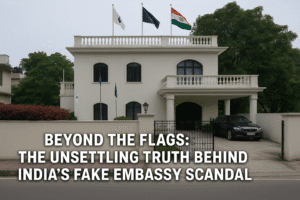Beyond the Flags: The Unsettling Truth Behind India’s Fake Embassy Scandal
For nearly eight years, Harshvardhan Jain operated an elaborate fake embassy from a rented Ghaziabad bungalow, exploiting the trappings of diplomacy to mask criminal enterprises. Using flags of obscure micronations like Westarctica, forged documents, diplomatic license plates, and photoshopped images with world leaders, he meticulously crafted an illusion of legitimate authority.
This facade enabled serious crimes, including defrauding job seekers and running illegal international money transfers (hawala networks). Jain exploited public deference to symbols of power and the ambiguous status of unrecognized micronations to lend his operation false credibility. His eventual arrest revealed a trove of counterfeit items and exposed significant gaps in oversight, demonstrating how easily fabricated legitimacy can deceive both individuals and systems when backed by convincing props.
The case underscores the vulnerability inherent in trusting visible symbols without deeper verification.

Beyond the Flags: The Unsettling Truth Behind India’s Fake Embassy Scandal
For nearly eight years, a rented bungalow in Ghaziabad, just outside New Delhi, wasn’t just a residence. Fluttering flags, parked luxury cars, and an imposing sense of officialdom marked it as a “diplomatic mission” to the untrained eye. It was an elaborate stage set, painstakingly constructed by Harshvardhan Jain – also known as “Baron H.V. Jain” – and its final curtain fell only this week with his arrest. This audacious scam reveals far more than one man’s criminal enterprise; it exposes vulnerabilities in perception, the allure of fabricated authority, and the surprising ease of diplomatic cosplay.
The Blueprint of Deception: How the Illusion Worked
Jain’s playbook was shockingly simple yet devastatingly effective:
- The Stage: Rent a prominent building. Check.
- The Props: Hoist official-looking flags (representing whichever micronation suited the moment: Westarctica, Seborga, or Poulbia Lodonia). Park luxury vehicles, often bearing counterfeit diplomatic license plates. Check.
- The Credentials: Masterfully photoshop himself into pictures with world leaders. Create fake passports, stamps, government seals, and documents. Check.
- The Narrative: Cultivate an “aura” of importance and unassailable diplomatic connections. Check.
This carefully constructed illusion wasn’t just for show; it was the engine for a multi-pronged criminal operation. Police allege the fake embassy served as a front for:
- Employment Fraud: Promising lucrative jobs abroad in exchange for hefty fees, exploiting desperate dreams.
- Hawala Networks: Facilitating illegal, cross-border money transfers hidden from authorities.
- General Impersonation & Fraud: Leveraging the perceived invulnerability of a “diplomat” to perpetrate other scams.
The Micronation Mirage: Exploiting the Gray Zone
The genius, and tragedy, of Jain’s scheme lay in his choice of cover: micronations. These are self-proclaimed “sovereign states” (like Westarctica, founded by an American, Travis McHenry, who styles himself “Grand Duke Travis”) that lack recognition from any established nation or the UN. They exist in a legal twilight zone – real enough to have websites and titles, but lacking any actual legal standing internationally.
Jain exploited this ambiguity masterfully. He reportedly secured an “honorary Consul to India” title from Westarctica after a “generous donation.” This veneer of legitimacy, however thin, provided crucial cover. As Senior Superintendent Sushil Ghule noted, “An undiscerning layman will believe what he sees and cannot tell that it’s all fraudulent.” The micronation connection offered just enough plausibility to disarm suspicion among those unfamiliar with the intricacies of international law and diplomatic recognition.
Westarctica has since distanced itself, stating Jain was an “authorized representative engaging in unauthorized activities” and was removed from their roster. Crucially, they confirmed he produced unauthorized diplomatic plates, passports, and seals – the very tools of his trade.
Why It Worked: The Psychology of Authority and Bureaucratic Blind Spots
Jain’s near-decade-long run highlights uncomfortable truths:
- Symbols Trump Substance: For many, the trappings of authority are authority. Flags, official-looking buildings, titles (“Baron”), and diplomatic plates trigger deep-seated societal deference. Jain weaponized these symbols.
- The Gap in Vigilance: How does a fake embassy operate undetected for years in a capital teeming with real ones? It suggests a potential blind spot. While genuine diplomatic missions are closely monitored, a residential building flying obscure flags might not immediately raise alarms, especially if operating subtly or targeting less sophisticated victims. Jain’s previous run-in (for possessing an illegal satellite phone in 2012) hints at a pattern of skirting rules that went unchecked for too long.
- Exploiting Hope and Ignorance: The victims of the employment scams were likely individuals blinded by the promise of a better life and unfamiliar with the legitimate processes for overseas work or the dubious nature of micronations.
Beyond the Arrest: Lasting Implications
Jain’s arrest is a start, but the case reverberates:
- A Wake-Up Call for Vigilance: It forces authorities and the public alike to question assumptions about legitimacy. Seeing shouldn’t always equate to believing, especially when ostentatious symbols are involved.
- Highlighting Micronation Risks: It shines an uncomfortable light on how easily the trappings of these unrecognized entities can be hijacked for serious crime, potentially prompting scrutiny of their activities globally.
- The Vulnerability of Trust: The scam fundamentally exploited human trust in institutions and symbols. Rebuilding that trust requires greater public awareness and more robust mechanisms to verify official claims, especially those promising life-changing opportunities.
The Final Curtain Call
Harshvardhan Jain’s fake embassy wasn’t just a criminal hub; it was a disturbing piece of performance art revealing the fragility of perception in the face of carefully staged authority. His arrest closes a bizarre chapter, but the questions it raises about how easily the lines between real and fabricated power can be blurred, and how long such illusions can persist under the noses of authorities, linger long after the flags have been taken down. It serves as a stark reminder that in a world saturated with symbols, genuine scrutiny remains our most vital defense against the most audacious deceptions.
You must be logged in to post a comment.